Mangoes. Sweet and delicious, healthy and invigorating, with all parts of the flesh being beneficial – is it any wonder they’ve been crowned the “king of fruits”?
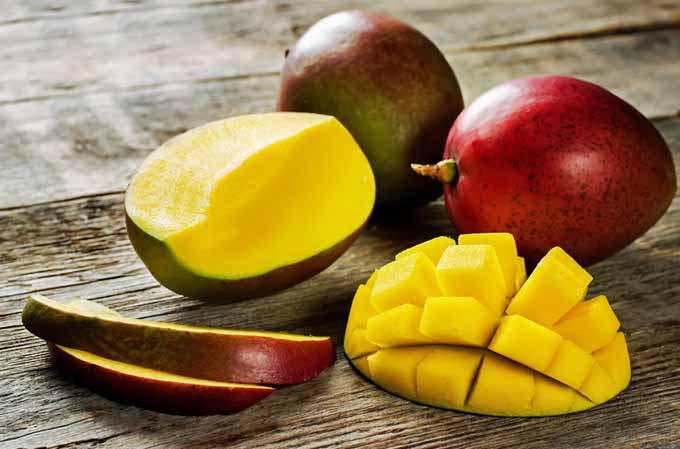
They bring tidings of good fortune, have had poems written about them in Sanskrit, and the Buddha supposedly found rest and repose in a mango grove.
Let’s explore a bit about the history and culture of this tempting fruit, as well as its outstanding nutritional value – and then we’ll savor its remarkable taste with a couple of recipes.
The King of Fruit
The first known cultivation of mangoes began some 5,000 years ago in the areas known today as southern India, Burma, and the Andaman Islands that skirt the Bay of Bengal.
It’s believed that around the fifth century A.D., Buddhist monks introduced them to eastern Asia and Malaysia.
Persian traders travelling along the spice routes carried the seeds to western Asia, with the first trees being planted in east Africa in the tenth century.
Later, in the sixteenth century, Portuguese explorers brought them to Brazil, and from there they spread throughout South and Central America. By the mid-1700s they were growing in Barbados in the West Indies, and cultivation soon followed in Florida and Mexico by the early nineteenth century, and California in the 1880s.
Foodal recommends “Mango” by Jen Karetnick for all those that love the King of Fruit and need more recipes.
Known as the “king of fruits” because many kings and noblemen in Southeast Asia had their own private groves. This was a source of great pride, as they were considered to be a symbol of status and social standing.
This is also the origin of baskets of the finest mangoes being given as gifts, which developed from the belief that they brought blessings of good fortune to a household (as indeed they would have, if a local king thought it fitting to bestow gifts from his own grove!).
Folklore
Mystical Urdu poets would eat the tender young buds, believing they would add sweetness to the voice of their poetry.

And the mango is well represented in iconography of eastern religions too, with the Hindu Lord Ganesh often seen holding one in an upturned palm as a symbol of attainment, while the Jain goddess Ambika is often portrayed sitting under a mango tree.
The popularity of the paisley print, with its teardrop shape, can be attributed to early Indian artists who revered the mango and used the motif in sculpture and jewelry. This was later embraced by Kashmiri weavers, creating shawls adorned with paisley patterns for ceremonial use.
Today in India, wreaths of its leaves still adorn the doorways and arches of homes during celebratory times and weddings, and the dried skin and seeds are used in Ayurvedic medicine.
In Australia, the first caseload of the year’s crop is usually auctioned off to benefit charity, a symbol of benevolence.
Growth
The fruit of the mango tree is what is known as a drupe; it has a fleshy outer structure called the mesocarp and a large, pithy stone in the center called an endocarp. Olives, dates and figs are also drupes, and cashews and pistachios are distant cousins.
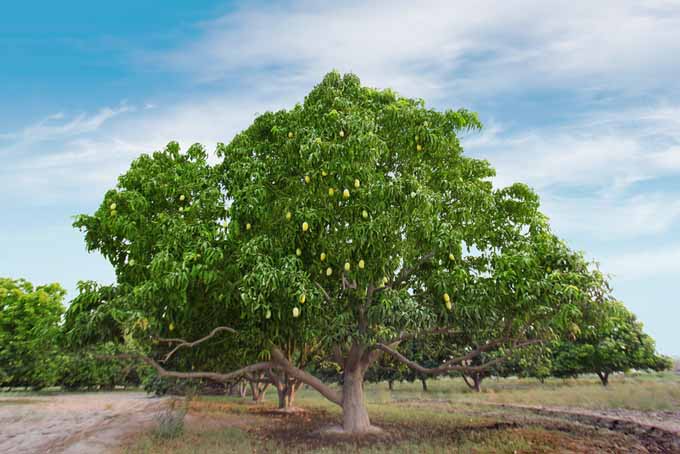
With hundreds of cultivars, this fruit comes in many different varieties, sizes, and colors, all of which are grown in frost-free tropical and subtropical regions.
India is still the primary producer of this delicious produce, but most of the fruit is consumed within the country, leaving very little for export. The main exporters today are Mexico, China, Thailand, Indonesia, Pakistan and Brazil.
Health and Nutritional Benefits
One cup of mango contains 100 calories, zero fat and cholesterol, 28 grams of carbohydrates, 3 grams of fiber, 23 grams of sugar, and 1 gram of protein. One cup of mango will fulfill 12% of your daily fiber requirements.
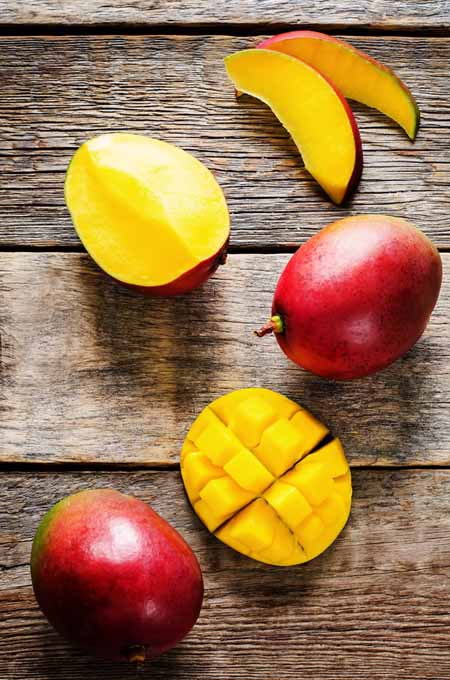
The same serving will also provide 100% of the daily recommended amount of vitamin C, 35% of vitamin A, 20% of folate, 10% of vitamin B6, and 8% of both vitamin K and potassium. They also provide copper, calcium, and iron, and are rich in the antioxidants beta-carotene and zeaxanthin.
With their rich vitamin A content and antioxidants, they may also help to regenerate and restore skin cells, while the vitamin C helps to boost collagen production.
Several studies also suggest that this healthful fruit can be beneficial in reducing the risk of obesity, diabetes, heart disease, some cancers, and macular degeneration, but research is still ongoing and as yet the evidence is inconclusive.
To soften skin, try this Mango Body Scrub:
In a blender, combine the fruit of one mango, one tablespoon of honey, two tablespoons of milk and a half cup of sugar.
Rub vigorously on your skin in the bath or shower, and rinse with warm and then cool water. It will leave your skin feeling soft and supple.
How to Select and Store
Mangoes are a seasonal fruit, but with today’s global marketplace, they’re readily available in most stores year round.
Most commercial growers harvest the fruit while still green but mature, while organic ones are usually left to ripen on the tree.
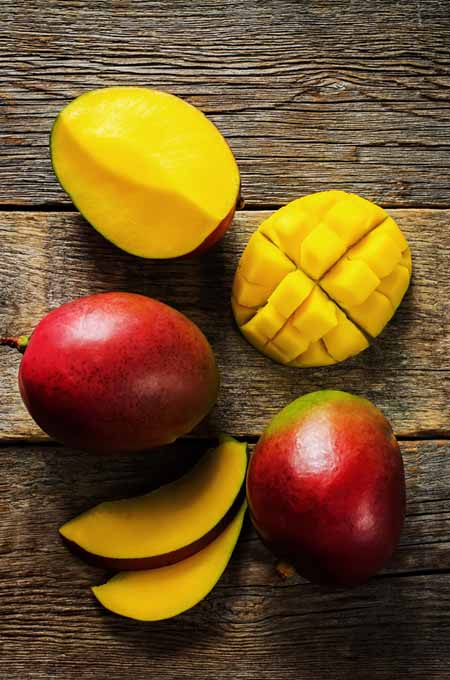
Mangoes come in a variety of colors, including yellow, orange, green, and red, but a red hue doesn’t necessarily mean it’s ripe.
To judge ripeness, squeeze gently. A ripe one will have a slight give with fingertip pressure, and will smell sweet at the stem end.
An unripe mango has a sour taste and astringent effect on your tongue and lips, so choose carefully if you’re planning to eat it the same day.
Choose fruit with fully intact skin that’s free of any bruises or cuts.
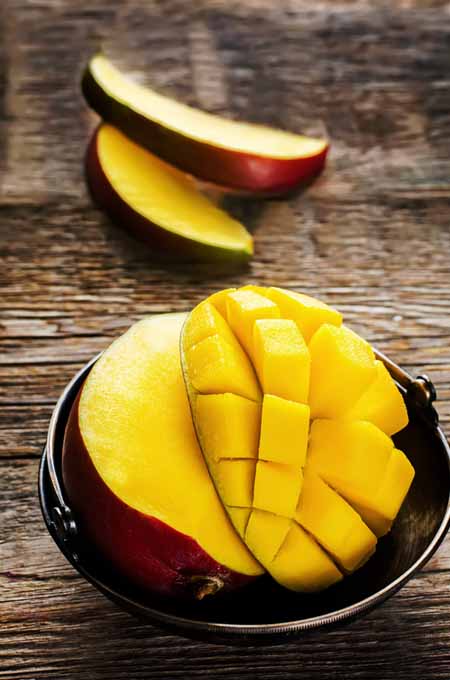
Mangoes that are still a bit green will ripen more quickly if placed in a brown paper bag out of direct sunlight. Otherwise, store at room temperature for a few days.
You can also slow down the ripening process by putting them in the fridge, but whole mangoes should not be frozen.
You can, however, cut up the ripe ones and combine them with sugar and tequila to make a refreshing, fruity homemade sorbet. You’ll find the recipe here.
Restore fresh mangoes to room temperature when you’re ready to eat, to get the full natural flavor.
How to Prepare and Eat
If you need help with how to cut fresh mango with ease, we advise you to read our tutorial here. We’ll show you every step of the way, and will also provide an alternative peeling/cutting method. You’ll also find more selection and storage tips in this article.
Suggestions:
- In Latin America, street vendors sell them skewered on a stick and peeled back for a cool, refreshing treat.
- In continuing Latin American tradition, cut them up and whip them into a tasty salsa.
- Enjoy them straight up with a shot of salt, lime juice or chili powder for a tasty flavor buzz.
- They’re a perfect addition to a cool fruit salad in summer.
- They work great in syrups and sauces.
- Try them in a salsa or chutney to accompany fish, chicken, pork and barbecued ribs.
- Superb in ice cream, they also make a great smoothie, or add to an Indian lassi yogurt drink.
And that’s our take on the marvelous mango. To see for yourself how tasty and versatile it is, try out the following recipes for Mango Salsa and Spicy Mango Chutney, and enjoy their sweet goodness.
Mango Recipes
Spicy Mango Chutney
This zesty chutney is a favorite as a relish for curry dishes as well as a topping for fish, chicken, and meat, and it also makes a fine accompaniment on a cheese platter. Plus, a jar is always popular for gift giving.
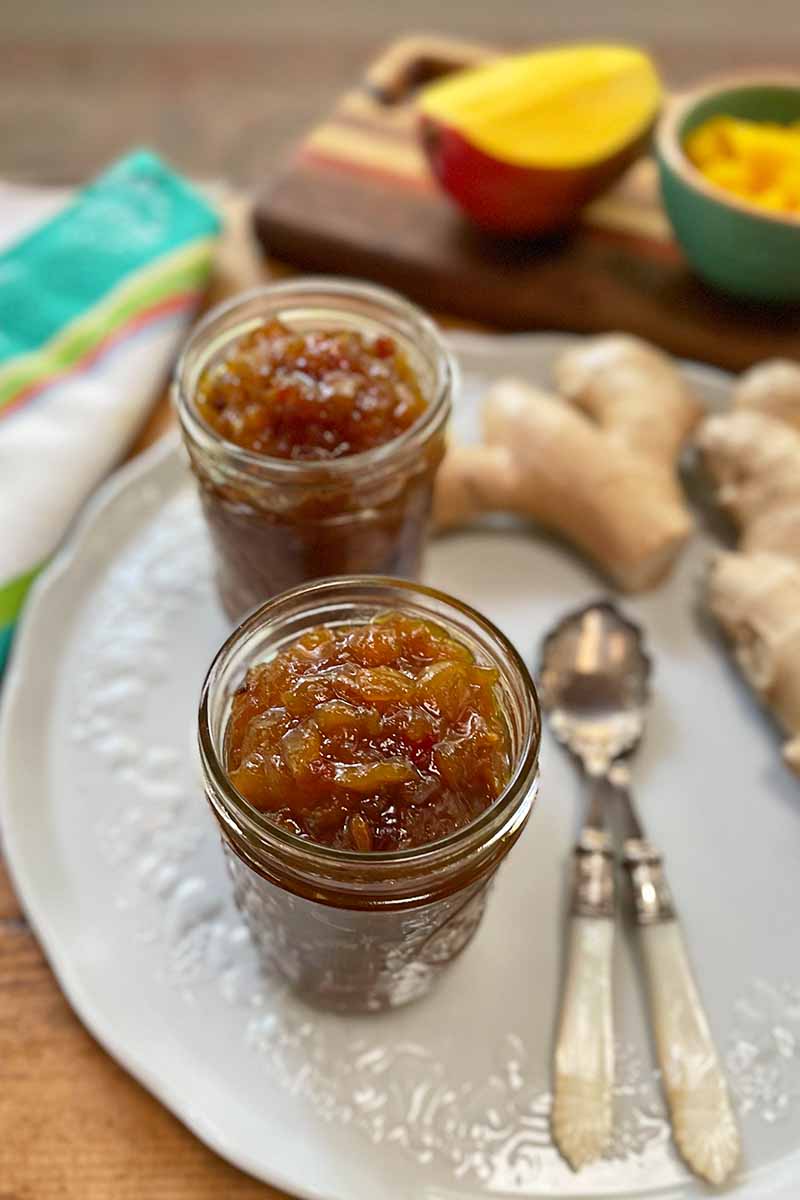
Spicy Mango Salsa
This salsa is great with your favorite tortilla chips, and makes a wonderful topping for grilled fish, chicken, or pork.
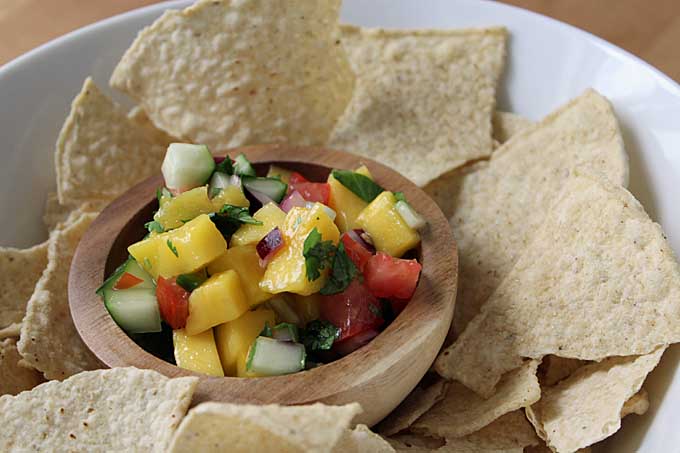
The sweet taste of mango pairs surprisingly well with hot peppers.
About Lorna Kring
Recently retired as a costume specialist in the TV and film industry, Lorna now enjoys blogging on contemporary lifestyle themes. A bit daft about the garden, she’s particularly obsessed with organic tomatoes and herbs, and delights in breaking bread with family and friends.

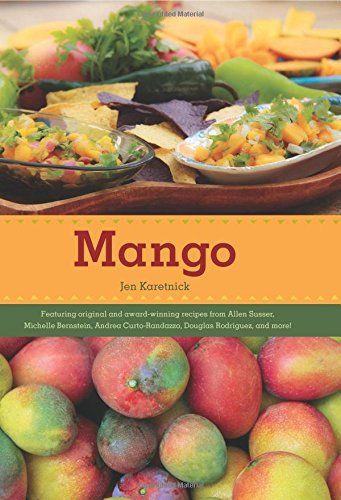



Sadly enough, I just tried one on its own for the first time a week or two ago. I’ve always had mango flavored things, and food items that contained small amounts. However, I had never had a raw and unblemished example by itself up until that point. I have to say that I like the plainer taste far more than I do the flavored drinks and foods, or even foods that contain the fruit.
There’s nothing quite like the taste of fresh troutski…
This was actually super useful as far as how to pick out a good mango. A few months back my local market had them on sale for $1 each, so I bought a bunch of them. Unfortunately I had no idea what a ripe example looked like (or in this case felt like) and picked a bad batch that left me disappointed…Completely unrelated. Does anyone else struggle to eat an entire fruit in one sitting? The sugar makes me feel sick to my stomach by the end. Too rich for my blood in one go.
Glad you found the post useful Dame 6089. And you’re right, they are very rich to eat a whole one in a single sitting. But, the stay good in the fridge for a couple of day and freeze well too – perfect for smoothies.
Mangoes are in my top three favorite fruits. They’re best when you can get them for free out of someone’s backyard, haha. (Offered, of course, not stolen!) And I’ve heard of the astringent effect but never actually experienced it. Around here we call that the “mango bite” – now I know it comes from unripe specimens. That salsa recipe looks delicious, so perhaps I’ll check out the farmer’s market and see if I can pick some fruit up this weekend.
Free fruit or veggies always rock Leopard, and they certainly do have a ‘bite’ if unripe… The salsa’s great with fish or grilled chicken, hope you like it.
The mango would be my most favorite fruit ever! I love how versatile it is as you can add it in many dishes and it’ll give different flavors every time. They add sweetness and sometimes sourness to loads of dishes. I like adding them to dishes but I absolutely love eating them as is. I’m a huge green mango addict and I eat the crisp and sour ones with either some rock salt or shrimp paste. They are amazing!
Hmmm, mixing them with shrimp paste… I’ll have to give it a try. Thanks for your mango enthusiasm keytcee!
I never had mangoes growing up. I didn’t have my first one until well into adulthood. Since then, I can’t seem to get enough of them. Recently, I’ve been trying to think of creative ways to eat them, and I really like the idea about eating them with a bit of salt, lime juice or chili powder. Also, I remember hearing that they may help enhance your mood, and possibly even prevent depression. Does anyone know anything about this?
I have heard of ‘mango mood’ pheonix2015. They contain vitamin B6 (about 10% of daily recommended allowances) which helps to promote the production of serotonin, one of the ‘feel good’ hormones. And diet is one of the best ways to get more serotonin to your brain, so eating them on a regular basis may just boost your mood!
My husband and I LOVE mangos. We always get so excited when they are in season, and then become sad again when the supply dries up. While I am not a huge fan of artificial mango flavor, I do love the soft flesh of the actual fruit; especially when it’s hot out and you eat some that was in the fridge not too long ago!
However, the problem I run into is that even if the outside of the specimen looks perfect and stunning, there have been times when I cut open the inside and the inside is all gross and rotten. Is there a way to prevent getting the bad ones or is it just luck of the draw?
Aside from X-ray vision tangela21, I think it is the luck of the draw. I do try to buy mine a bit under ripe as the brown center seems to happen in fruit that’s very ripe.
Ah! I wish I had the luxury to eat mango but unfortunately I have allergies to the chemicals that it gives off. My friends all love to eat mangoes, especially mango flavored ice cream, but I never knew that it was the King of Fruit! Perhaps I’m not fit to eat such a noble fruit it seems…
Thanks for commenting sunshine703, and too bad about the allergy… I’ve never heard of one to mango before.
Those are fantastic looking recipes, but you forgot one of the simplest ways to enjoy mango (other than as a raw fruit). We buy piles of them when they are in season, but usually just focus on eating the smaller ones. The large ones we carefully peel, slice, then let dry, usually in a food dehydrator. The dried mango keeps a lot of its sweetness, and then lasts us the rest of year. It’s good on it’s own, but we often eat it diced in in muesli or salads.
Ah, yes, dried mango is delicious! I like it in my trail mix and also use it in a fruit cake recipe that uses dried, tropical fruits. Thanks for pointing that out asbrown…
This is my 2nd favorite fruit of all time! My family has been eating them for as long as I can remember, but we normally don’t use them in cooking. The salsa recipe looks great though, so I might try that out. Thanks for sharing!
Hope you enjoy the salsa…
Other than the wonderful recipes mentioned above (love mango chutney), mangoes can also be pickled and used as sides during a meal. My mother and grandmother always have a batch of pickled mangoes ready for any meal. You can make different kinds of pickles too, slice them really small (the size of a fingernail) and pickle them with mustard seeds, or pickle them with loads of spices. There is even a type of small mango that are used just for pickling. Of course, it can only be pickled when it is green. In fact ,eating green mango raw with some salt and chilli powder is a treat all on its own !!
Pickled green mango sounds wonderful, will have to find a good recipe and give them a go. Thanks for your comments Raman_U.
Thank you so much for writing this! Mangoes are my most favourite fruits, and it’s the only flavour of smoothie I would even bother getting anytime the situation arises. Unfortunately, they’ve been quite expensive lately, and my busy lifestyle means that they get overripe before I know it, and it all goes to waste. I’ve tried dried mangoes, but it seems to be packed full of sugar and doesn’t fill you up as much. I’m definitely looking forward to trying out these recipes, and hopefully they last longer for me!
Trying freezing them when you know you won’t get to them fresh. Put the whole mango in the freezer if you’re really pressed for time, and peel and slice for smoothies later. Enjoy the chutney and salsa!
Bookmarked.
Came for the cutting instructions, reading the rest of the cool stuff with tomorrows coffee 😉
Awesome, thanks jony.
I had no idea there was so much to the mango. I thought it was just another fruit! I am totally amazed at the nutrition it contains and at the wealth of different things you can do with it. It is good to know this because now I can make the most of what fruit I buy and ensure that my families nutrition is maximized.
It is good to know oraclemay – tasty and nutritious, it’s worth having in the fruit bowl.
Throughout my pregnancy I’ve craved mangoes. I just recently ran out of them last week and I’m extremely sad. I had forgotten about them until now lol. I never remember learning about poets eating buds thinking it would bring sweetness to their work. That’s pretty crazy the amount of power they felt a fruit had. As far as recipes, here in downtown Miami you can get a bag of mangoes submerged in vinegar and black pepper. It’s really simple but the burst of flavors is incredible. I really recommend it!
Kind of like pickled mango, and it does sound great – the sweet and sour would make an enticing flavor compliment. Will have to give it a try, thanks for the idea denelizr!
I love mangoes. The history of the fruit and how it traveled the world is so cool. I never knew that paisley designs were inspired by their shape. I love to crochet and have seen paisley designs. I also love to crochet pineapple motifs and pineapples are a sign of hospitality.
Isn’t it interesting where inspiration comes from? Thanks for your comments.
I’m impressed by reading the health benefits of mango. I’ve only tried it one time, and I believe it wasn’t ripe enough, because it tasted slightly bitter. I’ll have to look when I get to the store, and see if there are any for sale. I don’t always see them, but now that I’ve read this, I’m curious to see if i can pick a ripe one, and try one of your recipes, or maybe make the paleo ice cream.
That slight bitterness is a sign of under-ripeness Diane, and it can be quite astringent tasting. Try a ripe one and you’ll be impressed with the difference in taste – it’s a lot like choosing an avocado. You want a slight give to the flesh when pressed firmly, but not too soft or it will be overripe, and not too hard or they’ll be green.
It never occurred to me that mango is in any way similar to other pitted foods like olives or dates.
This is one of those fruits I don’t eat very often, but when one catches my eye in the supermarket, there’s nothing like it. I really have to be in the mood, though. They can be messy, and I like my them straight up, right off the pit, so I have to be ready for that.
I feel like papaya is in the same category to me, and I’ve noticed some similarities in their textures and flavors.
I also think this is one of those fruits that is really great ingredient. That is, when I eat fruit, I like it plain and fresh, usually not cooked or prepared. Mango is an exception, as I always enjoyed mango-flavored dishes or desserts. I love chutney and salsa. I’ll have to try out these recipes.
Straight up does seem to call for a hot summer day at the beach, they can be pretty sticky! Very similar to papaya in many ways, I think they’re pretty much interchangeable.
Mangoes are a top priority for me and I always make sure to have them in my fridge. Not only you can make some delicious dishes with them but smoothies also taste really great if you add a touch. Definitely up there for me, alongside kiwis and pineapple.
That’s an awesome tropical trio, great in smoothies and fruit salads.
This is undoubtedly one of my favorite fruits. Mango juice was my grandfather’s favorite drink before he passed, and he always bought the best kind: rich but not chalky (unfortunately, the kind made in America always seems to be weak and watery). The salsa and chutney both look amazing! I love the added pop the mango gives to the color of the salsa especially. Thank you also for all the nutritional information! This will definitely help me the next time I plan to go on a diet.
When overripe mangoes are on sale I’ll buy a bunch for the juicer – definately different than store bought! Glad you enjoyed the post Liv6, hope the nutritional info is helpful for you.
Lovely article. Full of information. I must say, I had no idea that a mango had so much goodness and that it is helpful in illnesses. Mango is delicious and I do agree that it should be eaten far more often. It is a fruit that is often left out.
Thanks oraclemay, glad you enjoyed the post. I think it gets overlooked a bit because it’s perceived as being difficult to peel and pit – but the fruit itself makes the effort well worth while.
Your arty was quite informative. I love mangoes, I would eat them for breakfast lunch and dinner during mango season. I however can’t seem to enjoy mango flavored products. Whether it be in drinks or in solid foods.
I hear what you’re saying Zhen, fresh and manufactured mango flavor are two completely different things to my taste buds. Glad you enjoyed the post, and thanks for your comments.
I never really are mangos until I travelled to the Caribbean. After eating what tasted like the freshest fruit I fell in love with mangos. I don’t think the ones I find here in the U.S. are as good as the ones I had there.
They are great to throw in smoothies because they are set enough to counter the taste of spinach and kale.
They’re so easy to love Kimmy! I haven’t tried them in a smoothie with greens, but I do juice them with veggies for my own version of V-8 juice – and they always add a great taste.
I never knew that mangos were once a status symbol… It reminds me of the part in Little Women where in the elementary school of the youngest sister tiny sour lemons are the it thing and an absolute social necessity.
Funny how things change. I love those kind of cultural tidbits, even though I prefer other fruit to mango.
Scarcity does seem to make things more valuable in our minds Ep! Glad you enjoyed you enjoyed the post.
In my personal opinion I wouldn’t crown mangos the king of fruits, I like blueberries way more. But they still taste awesome. Also I thought the durian was the king of fruits, perhaps I’m mixing something up here. I love the mini history lesson though, very informative. I always learn new things with these articles. I absolutely love mango lassi and was surprised to see it wasn’t included here but then I saw the recipe in another article and had to smile. I knew the iconic mango lassi was somewhere here. This also looks like a plant I can grow in my backyard, finally. I was getting upset over not being able to grow my own cranberries and sea buckthorn berries.
Lassi’s wonderfully refreshing NN, glad you found the recipe – and enjoyed the post!
I’m from the Philippines and we have A LOT of mangoes here! I love them ripe or unripe. Here, it’s pretty common to find unripe/green mangoes sold on the streets. There are different varieties that you can enjoy. We have Indian mangoes that have green peelings but are definitely sweet to the bite. There’s another ‘green’ variety (I don’t know what it’s called) that will make you salivate just by thinking about it. It definitely has a bite, and we often dip it in a especially prepared shrimp paste (only for green mangoes) or just with salt.
A lot of our mangoes are also exported. Sadly, the good quality often end up sold outside the country. Dried mangoes from Cebu are also best-sellers among foreigners. Because of its abundance, you can expect that most restaurants here serve green or ripe mango shakes.
I’ve had the green mango with shrimp paste saravet, and it’s wonderful! How great for you to have such an abundance – I’m envious!
This has always been one of my favorite fruits next to pineapple. As a child, I always looked forward to rainy seasons where I grew up in the tropics and once they began to ripen, I could have a dozens for lunch. I love the variety of ways one can eat and serve them.
Sounds like you grew up in a tropical fruit Garden of Eden darkrebelchild! Thanks for your comments.
I’m not much of a mango person even though I have a large mango tree going in my backyard. I do eat them though but not consistently. Its health benefits are amazing though. OH and what a fun little video in the article! Never knew peeling mangoes could be that easy.
Isn’t that just the coolest idea for peeling them?! I’m quite envious that you have a tree in your backyard Canary, enjoy one for me!
I’m a bit of a history buff, so this article was extremely entertaining to me. I surprisingly knew very little of this information before reading it! I was glad that it included a recipe for mango salsa. I only started making mango salsa a few months ago. However, I love it to top grilled protein, especially fish and chicken. It looks so wonderful and tastes even better. It is a must-try for your next cookout because it really dresses up the presentation and your guests will love it.
The salsa’s delish alright, great with pork and lamb too… glad you enjoyed the post Lisa!
Well at least there is something that might be a positive that I can get from this terrible and excessive hear that we are getting this summer. It is brutal here, with temperatures in the hundreds and lots of humidity, which makes for that sticky hear. This is the time of year that you can usually get good mangoes though, and for that I am thankful. I do not eat nearly enough of these as I know that I should. Thanks for the reminder though, and I intend to pick some up later today. They are delicious.
Oh, I’m pea-green with envy at the thought of mangoes growing in the garden… I had one sprout in the compost and potted it up. Alas, it couldn’t handle a Canadian winter – no mangoes.
Thanks for posting this! Mangos are one of my favorite fruits, and they sell them all over where I live. You can find mango salsa, mango fruit popsicles (which are my favorite this time of year), mangos sprinkled with chili, mango boba tea…the list goes on. I personally like to serve them sliced with warm coconut sticky rice. I do have a question about mangos: when I lived in India, I was told that mangos are a “heating” food, which seems a little unusual for a fruit. Can anyone tell me why mangos are considered “heating”?
Ah mangoes – love them! The fact that they are good for me is just a bonus really!
I can’t bring myself out turn one into a skin scrub as I want to eat them, but the chutney and salsa recipes I will have to try in a month or so when mangoes are in season.